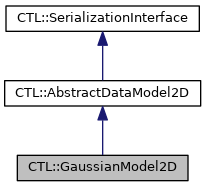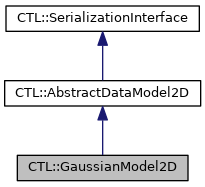The GaussianModel2D class represents a two-dimensional Gaussian curve. More...
#include <datamodels2d.h>


Public Types | |
| enum | { Type = 1002 } |
 Public Types inherited from CTL::AbstractDataModel2D Public Types inherited from CTL::AbstractDataModel2D | |
| enum | { Type = 1000 } |
 Public Types inherited from CTL::SerializationInterface Public Types inherited from CTL::SerializationInterface | |
| enum | { Type = -1, UserType = 65536 } |
Public Member Functions | |
| int | type () const override |
| float | valueAt (float x, float y) const override |
| Returns the value from the model at position (x, y). More... | |
| AbstractDataModel2D * | clone () const override |
| GaussianModel2D (float amplitude=1.0f, float mean=0.0f, float std=1.0f, float correlation=0.0f) | |
| Constructs a GaussianModel2D; a model representing a two-dimensional Gaussian curve. More... | |
| GaussianModel2D (float amplitude, float meanX, float meanY, float stdX, float stdY, float correlation=0.0f) | |
| Constructs a GaussianModel2D; a model representing a two-dimensional Gaussian curve. More... | |
| QVariant | toVariant () const override |
| QVariant | parameter () const override |
| void | setParameter (const QVariant ¶meter) override |
| Sets the parameters contained in parameter (a QVariantMap). More... | |
| virtual void | setParameter (const QVariant ¶meter) |
| void | setParameter (const QString &name, const QVariant &value) |
 Public Member Functions inherited from CTL::AbstractDataModel2D Public Member Functions inherited from CTL::AbstractDataModel2D | |
| void | setParameter (const QString &name, const QVariant &value) |
| void | fromVariant (const QVariant &variant) override |
| QString | name () const |
| void | setName (const QString &name) |
| Chunk2D< float > | sampleChunk (const SamplingRange &xRange, const SamplingRange &yRange, uint nbSamplesX, uint nbSamplesY) const |
 Public Member Functions inherited from CTL::SerializationInterface Public Member Functions inherited from CTL::SerializationInterface | |
| virtual | ~SerializationInterface ()=default |
Private Member Functions | |
| void | setSaveCorr (float corr) |
| Helper function to set correlation value within valid range. | |
| void | setSaveStdX (float std) |
| Helper function to set standard deviation value within valid range. | |
| void | setSaveStdY (float std) |
| Helper function to set standard deviation value within valid range. | |
Private Attributes | |
| float | _ampl = 1.0f |
| float | _meanX = 0.0f |
| float | _meanY = 0.0f |
| float | _stdX = 1.0f |
| float | _stdY = 1.0f |
| float | _corr = 0.0f |
Friends | |
| template<class > | |
| struct | SerializationHelper::RegisterWithSerializationHelper |
Additional Inherited Members | |
 Protected Member Functions inherited from CTL::AbstractDataModel2D Protected Member Functions inherited from CTL::AbstractDataModel2D | |
| AbstractDataModel2D (const AbstractDataModel2D &)=default | |
| AbstractDataModel2D (AbstractDataModel2D &&)=default | |
| AbstractDataModel2D & | operator= (const AbstractDataModel2D &)=default |
| AbstractDataModel2D & | operator= (AbstractDataModel2D &&)=default |
 Protected Member Functions inherited from CTL::SerializationInterface Protected Member Functions inherited from CTL::SerializationInterface | |
| SerializationInterface ()=default | |
| SerializationInterface (const SerializationInterface &)=default | |
| SerializationInterface (SerializationInterface &&)=default | |
| SerializationInterface & | operator= (const SerializationInterface &)=default |
| SerializationInterface & | operator= (SerializationInterface &&)=default |
 Related Functions inherited from CTL::AbstractDataModel2D Related Functions inherited from CTL::AbstractDataModel2D | |
| std::shared_ptr< AbstractDataModel2D > | operator+ (std::shared_ptr< AbstractDataModel2D > lhs, std::shared_ptr< AbstractDataModel2D > rhs) |
| std::shared_ptr< AbstractDataModel2D > | operator- (std::shared_ptr< AbstractDataModel2D > lhs, std::shared_ptr< AbstractDataModel2D > rhs) |
| std::shared_ptr< AbstractDataModel2D > | operator * (std::shared_ptr< AbstractDataModel2D > lhs, std::shared_ptr< AbstractDataModel2D > rhs) |
| std::shared_ptr< AbstractDataModel2D > | operator/ (std::shared_ptr< AbstractDataModel2D > lhs, std::shared_ptr< AbstractDataModel2D > rhs) |
| std::shared_ptr< AbstractDataModel2D > & | operator+= (std::shared_ptr< AbstractDataModel2D > &lhs, const std::shared_ptr< AbstractDataModel2D > &rhs) |
| std::shared_ptr< AbstractDataModel2D > & | operator-= (std::shared_ptr< AbstractDataModel2D > &lhs, const std::shared_ptr< AbstractDataModel2D > &rhs) |
| std::shared_ptr< AbstractDataModel2D > & | operator *= (std::shared_ptr< AbstractDataModel2D > &lhs, const std::shared_ptr< AbstractDataModel2D > &rhs) |
| std::shared_ptr< AbstractDataModel2D > & | operator/= (std::shared_ptr< AbstractDataModel2D > &lhs, const std::shared_ptr< AbstractDataModel2D > &rhs) |
Detailed Description
The GaussianModel2D class represents a two-dimensional Gaussian curve.
This model maps input values according to a two-dimensional Gaussian function.
Constructor & Destructor Documentation
◆ GaussianModel2D() [1/2]
|
explicit |
Constructs a GaussianModel2D; a model representing a two-dimensional Gaussian curve.
This creates a model representing a two-dimensional Gaussian function specified by amplitude, mean, std, and correlation.
The passed parameters mean and std will be uses for both dimensions. Same as GaussianModel2D(amplitude, mean, mean, std, std, correlation).
Note that the input to std must be strictly positive, i.e. std > 0; and correlation must be between (excluding the borders) -1 and 1, i.e. -1.0 < correlation < 1.0.
Throws an std::domain_error for invalid input.
- See also
- valueAt()
◆ GaussianModel2D() [2/2]
| CTL::GaussianModel2D::GaussianModel2D | ( | float | amplitude, |
| float | meanX, | ||
| float | meanY, | ||
| float | stdX, | ||
| float | stdY, | ||
| float | correlation = 0.0f |
||
| ) |
Constructs a GaussianModel2D; a model representing a two-dimensional Gaussian curve.
This creates a model representing a two-dimensional Gaussian function specified by amplitude, meanX, meanY, stdX, stdY, and correlation.
Note that the input to both standard deviation parameters (stdX, stdY) must be strictly positive, i.e. stdX > 0, stdY > 0; and correlation must be between (excluding the borders) -1 and 1, i.e. -1.0 < correlation < 1.0.
Throws an std::domain_error for invalid input.
- See also
- valueAt()
Member Function Documentation
◆ parameter()
|
overridevirtual |
Returns the parameters of this model as a QVariant.
Default implementation returns an empty QVariant. Override in custom classes to encode all relevant information from the class' members. The returned QVariant must contain all information to fully specify the objects state. In particular, calling setParameter(parameter()) should not change the state of an object.
Reimplemented from CTL::AbstractDataModel2D.
◆ setParameter() [1/3]
|
overridevirtual |
Sets the parameters contained in parameter (a QVariantMap).
The value passed to parameter must be a QVariantMap containing one or multiple of the following (key, value)-pairs:
-("amplitude", [float] amplitude), -("meanX", [float] meanX), -("meanY", [float] meanY), -("stdX", [float] stdX), -("stdY", [float] stdY), -("correlation", [float] correlation).
stdX and stdY must be strictly positive, i.e. i.e. stdX > 0, stdY > 0; for other input, a warning is generated and a default value of 1.0 will be set. correlation must be between (excluding the borders) -1 and 1, i.e. -1.0 < correlation < 1.0; for other input, a warning is generated and a default value of 0.0 will be set.
Example: setting mean in y direction to 3, amplitude to 2.5 and a correlation of 0.5
Reimplemented from CTL::AbstractDataModel2D.
◆ setParameter() [2/3]
| void CTL::AbstractDataModel2D::setParameter |
Sets the parameter with tag name to value, by passing a QVariantMap containing only the name, value pair as its sole entry to setParameter(const QVariant&).
This method is only useful if setParameter(const QVariant&) is implemented in a way that it allows for individual parameters to be set if the QVariant passed to it does only contain a selection of parameters. When overriding setParameter(const QVariant&) in custom classes, this method will be shadowed. In case you implemented setParameter(const QVariant&) in the way described above (i.e. such that setting individual parameters is possible), re-enable this method in the sub-class via
.
◆ setParameter() [3/3]
| void CTL::AbstractDataModel2D::setParameter |
Sets the parameters of this model based on data held in parameter.
Default implementation does nothing. Override in custom classes to extract all relevant information from parameter and set class members accordingly. A call to this method (given an appropriate input parameter) should prepare the full state of the object. In particular, calling setParameter(parameter()) should not change the state of an object.
◆ toVariant()
|
overridevirtual |
Interface to store all member variables in a QVariant.
Stores the object's type-id.
Reimplement this method such that it stores all newly introduced object data when sub-classing. This needs to cover everything that is necessary to fully determine the state of an object. Best practice is to invoke the base class version of this method to take care of all content originating from underlying base classes.
A typical reimplementation in sub-classes might look like this:
Reimplemented from CTL::AbstractDataModel2D.
◆ type()
|
inlineoverridevirtual |
Returns the type-id of the serializable object. Used in deserialization to determine the proper object type.
Add derived classes to the enumeration using the CTL_TYPE_ID macro.
Reimplemented from CTL::AbstractDataModel2D.
◆ valueAt()
|
overridevirtual |
Returns the value from the model at position (x, y).
With the defining parameters of the Gaussian curve according to the constructor (see GaussianModel2D()):
- amplitude: \( A \)
- meanX: \( \mu_x \)
- meanY: \( \mu_y \)
- stdX: \( \sigma_x \)
- stdY: \( \sigma_y \)
- correlation: \( c \)
the resulting value is given by follwoing relation:
\( f(x)= \frac{A}{2\pi \sigma_x \sigma_y \sqrt{1-c^2}} \cdot \exp\left[-\frac{1}{2 (1-c^2)} \cdot \left( \frac{(x-\mu_x)^2}{\sigma_x^2} + \frac{(y-\mu_y)^2}{\sigma_y^2} - \frac{2c \cdot (x-\mu_x)(y-\mu_y)}{\sigma_x \sigma_y} \right) \right] \)
Implements CTL::AbstractDataModel2D.
The documentation for this class was generated from the following files:
- modules/src/models/datamodels2d.h
- modules/src/models/datamodels2d.cpp
 1.8.16
1.8.16